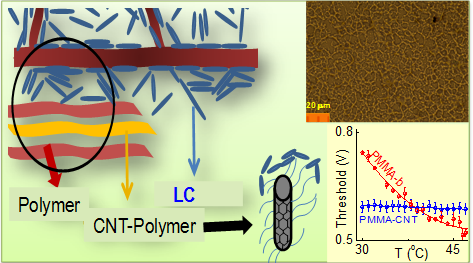Carbon nanotube reinforced polymer stabilized liquid crystal device
S. Krishna Prasad, Marlin Baral, A. Murali and S. N. Jaisankar,
ACS Appl. Mater. Interfaces, 9, 26622 −26629 (2017)
Polymer stabilized liquid crystal (PSLC) devices comprise a polymer matrix in an otherwise continuous phase of a liquid crystal. The fibrils of the polymer provide, even in the bulk, virtual surfaces with finite anchoring energy resulting in attractive electro-optic properties. Here we describe a novel variation of the PSLC device fabricated by reinforcing the polymer matrix with polymer-capped single-walled carbon nanotubes (CNTs). The most important outcome of this strengthening of the polymer strands is that the threshold voltage associated with the electro-optic switching becomes essentially temperature independent in marked contrast to the significant thermal variation seen in the absence of the nanotubes. The reinforcement reduces the magnitude of the threshold voltage, notably accelerates the switching dynamics and the effective splay elasticity. Each of these attributes is quite attractive from the device operation point of view, especially the circuit design of the required drivers. The amelioration is caused by the polymer decorating CNTs being structurally identical to that of the matrix. The resulting good compatibility between CNTs and the matrix prevents the CNTs from drifting away from the matrix polymer, a lacuna in previous attempts to have CNTs in PSLC systems. The difference in the morphology, perhaps the primary cause for the effects seen, is noted in the electron microscopy images of the films.
Posted by S. Krishna Prasad

